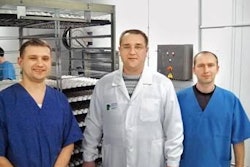Dietary calcium is required for developing pullets and laying hens to supply adequate quantity and quality calcium for bone calcification, eggshell calcification and other physiological needs. It is important that an adequate quantity of calcium be available as well as adequate amounts of large particle size calcium.
Traditionally, only small particle size calcium sources, less than 0.5 millimeters in diameter, have been utilized in pullet feeds. As the pullet comes into egg production, larger particle size calcium sources, such as limestone, oyster shell and eggshell, are blended into rations at varying ratios of fine to large particle sizes.
The Hy-Line International Management Guide for W-36 hens recommends a blend of calcium sources where 65 percent is made up of large particle sources, 2-4 millimeters, as the hen starts and continues into egg production. The large particle size calcium sources can be mixed into the ration or, in some cases, top-dressed when needed to improve shell quality.
Particle size impact on pullets
At the University of Nebraska, we have been conducting research on the use of larger size calcium particles, 0.9 millimeters, during the pullet rearing phase to see if skeletal strength can be improved in preparation for egg laying. Our first trial (reported by Eusebio et al. at the 2013 International Poultry Symposium) compared two limestone products from Iowa Limestone Resources; the first was the Unical S product, which has a size of 0.431 millimeters, compared to the FreFlo product that has an average mesh size of 0.879 millimeters. The limestone products were fed to Bovan White and Lohmann Brown hens from 7 to 17 weeks of age in a traditional cage system versus the new Big Dutchman aviary systems. Bone mineral density increased significantly in brown hens housed in cages when fed the larger sized limestone particles. There was a trend for increased bone mineral density in the Bovan whites fed larger limestone particles in the cage system as well (see Graph 1).
In addition to bone mineral density, keel bone deformities were also measured in the young pullets. One may not expect to see keel bone deformities in pullets before lay, but surprisingly, based on palpation, Eusebio was able to detect breaks and crookedness in pullets less than 16 weeks of age. There is nearly a two-fold reduction in the incidence of keel bone deformities when the larger particle size limestone was fed (see Graph 2). This research is being carried into the layer phase of production to determine long term effects of improved bone and skeletal quality during the pullet period on egg shell quality.
Alternative calcium sources
In addition to the particle size of a calcium source, the availability and price of the calcium source are important. Oyster shells have been an ingredient in poultry rations as a large particle size calcium source for decades. Unfortunately, with rising transportation costs, many land-locked egg producers are not close enough to an affordable oyster shell market. Dried eggshells from egg breaking plants can also be utilized in poultry rations as a viable source of calcium.
Scheideler (1998) published research on the utilization of eggshell calcium by laying hens. Dried eggshell products from two egg breaking plants were compared to limestone and oyster shell in various fine to large particle size combinations. The dried eggshell particle size ranged from 0.4 to 2.0 millimeters, providing an interesting blend of fine to large particles, with the majority of it in the 0.6-2.0 millimeter range. Calcium digestibility of hens fed eggshell calcium ranged from 38 to 46 percent, which was comparable to the all limestone treatment, 47.5 percent, and the limestone to oyster shell combination treatment, 33.9 percent.
Recycling eggshell waste as a feed ingredient is a viable option for breaker operations. When eggshells and oyster shell are not available, limestone becomes the primary calcium source. Fortunately, limestone starts large and can be ground down to the mesh size the producer needs. Limestone solubility can vary according to quarry, so the producer may need to investigate their most economical choice along with quality and availability.

















